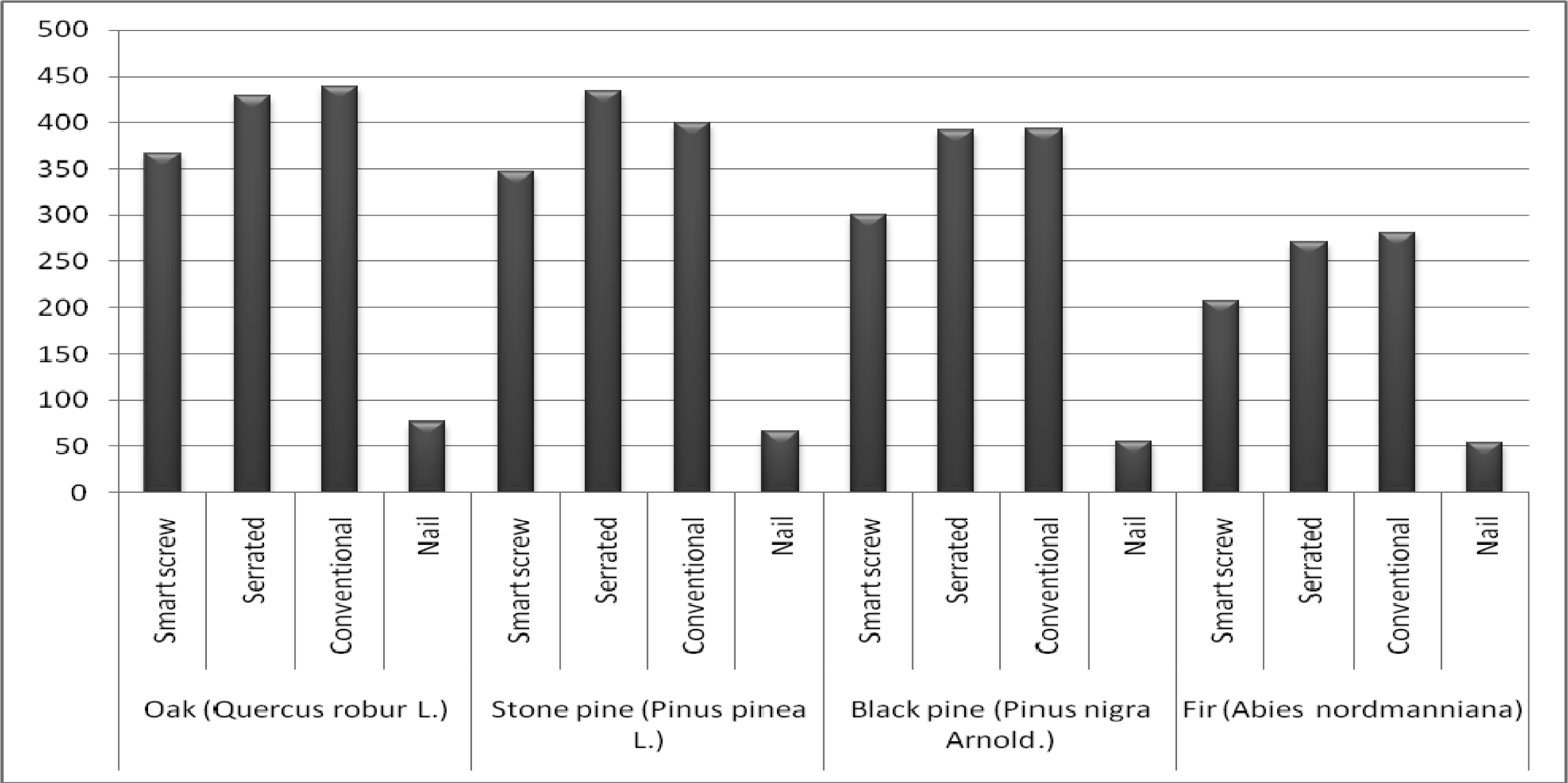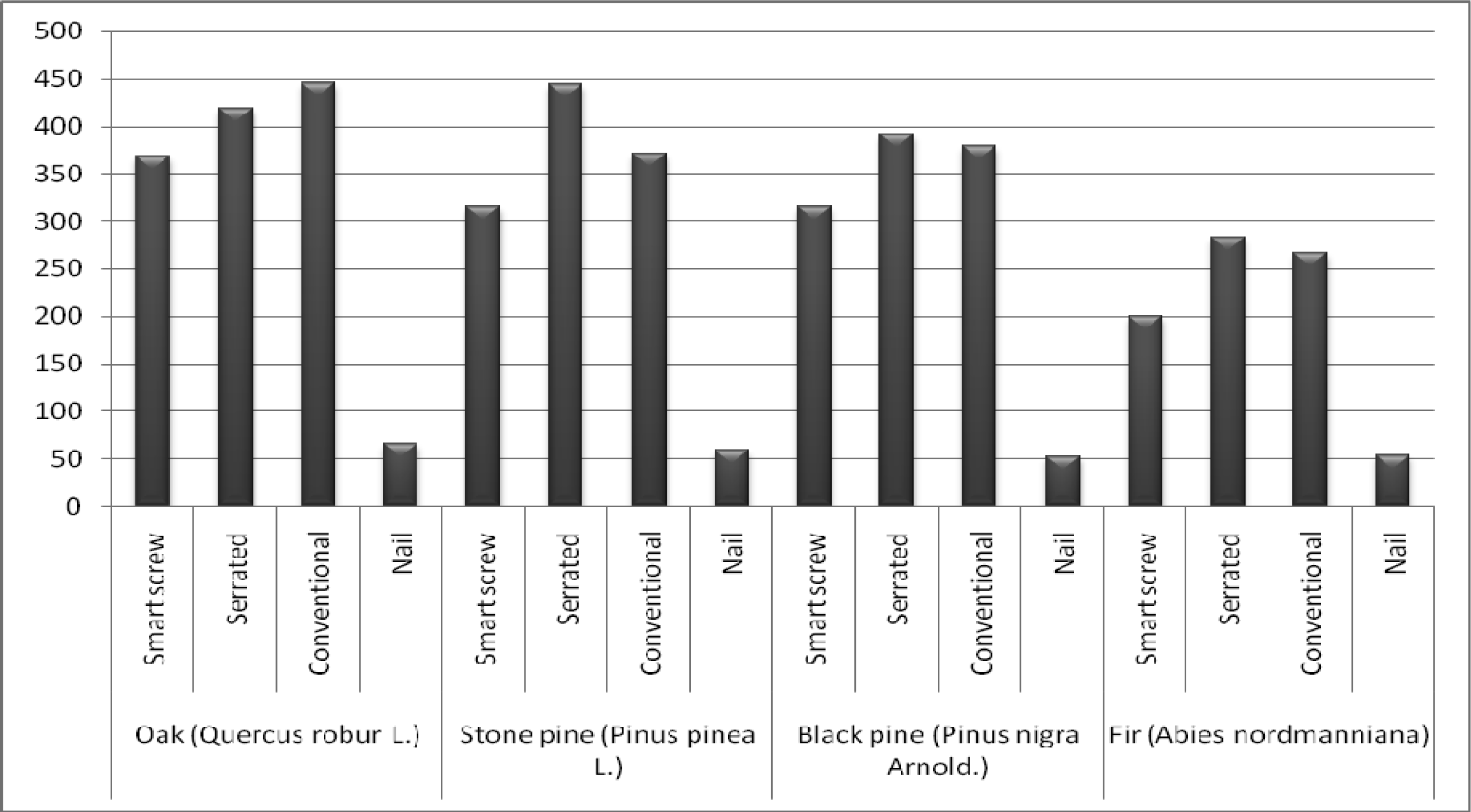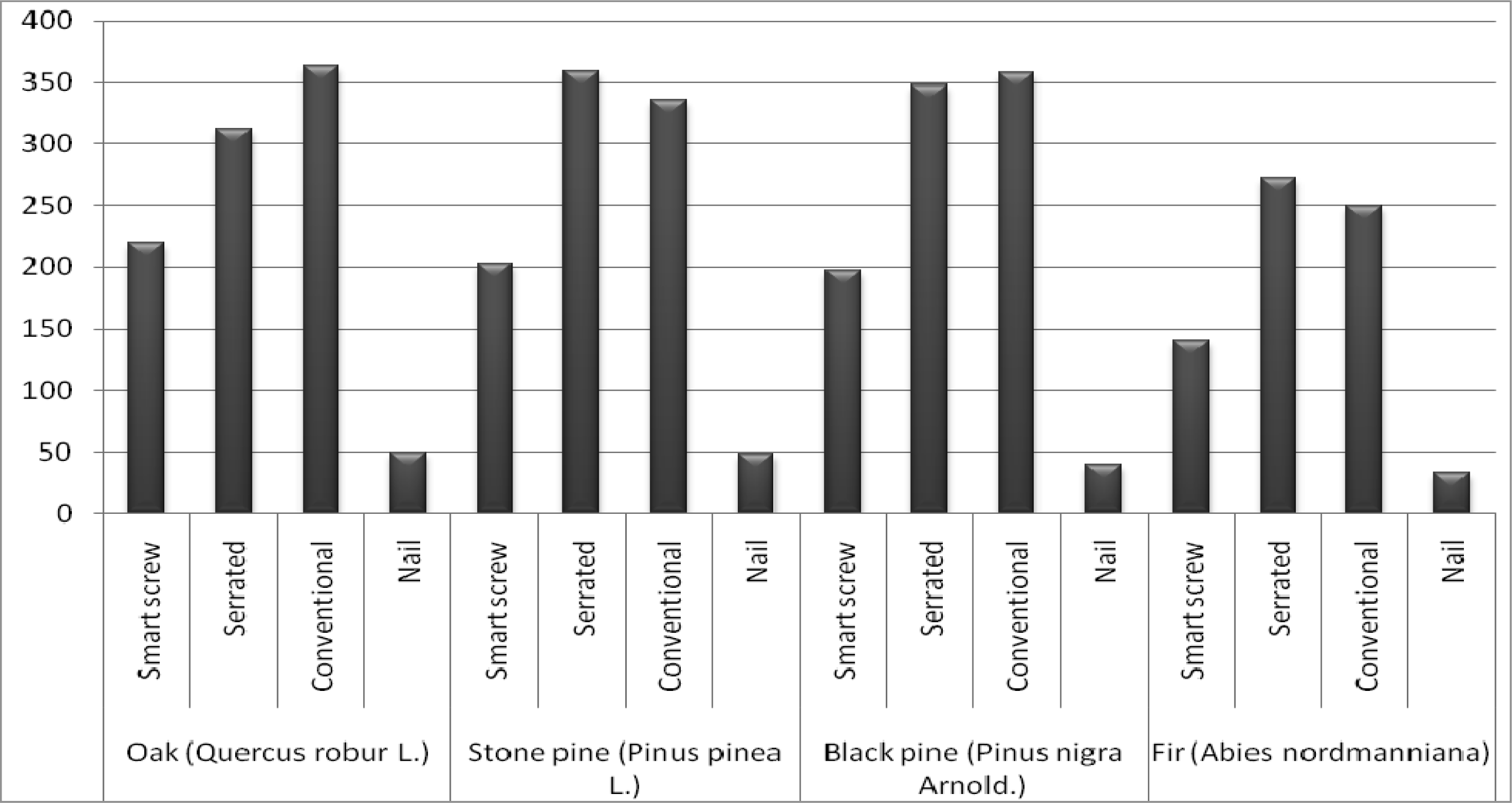Determination of Screw and Nail Withdrawal Resistance of Some Important Wood Species
Abstract
1. Introduction
2. Materials and Methods
2.1. Materials
2.2. Methods
| P | The maximum pull of power (kgf) |
| G | The density of the wood (g/cm3) |
| D | The diameter of the screw body (mm) |
| L | The depth of the ribbed part of the screw (mm) |
| P | The allowed design value (groove portion of screw for 25.4 mm insertion depth for each) (kgf) |
3. Results and Discussion
3.1. Withdrawal resistances for radial direction
3.2. Withdrawal resistances for tangential direction
3.3. Withdrawal resistances for longitudinal direction
3.4. Nail and screw withdrawal resistances for wood species
3. Conclusions
References
- Ferah, O. Determination of Nail and Screw Withdrawal Resistance of Some Important Wood Species; Report for the Institute of Forestry Resource: Ankara, Turkey, 1991; Technical Note No. 252. [Google Scholar]
- Doğanay, S. Determination of Screw Withdrawal Resistance of Wood Using in Furniture Industry; Master Thesis; Gazi University, Technical Education Faculty: Ankara, 1995. [Google Scholar]
- Helinska-Raczkowska, L. Withdrawal Resistance of Nails from Juvenile Wood of Scots Pine. Sylwan 1993, 137(9), 31–36. [Google Scholar]
- Fujita, S. Withdrawal Resistance of Some Nails to Sugi Wood Growing in Takakuma University Forest. Bulletin of the Faculty of Agriculture, Kagoshima University 1990, 40, 201–206. [Google Scholar]
- Broker, FW; Krause, HA. Preliminary Investigations on the Holding Power of Dynamically Loaded Wood-Screws. Holz als Roh und Werkstoff 1991, 49(10), 381–384. (in German). [Google Scholar]
- Bues, CT; Schulz, H; Eichenseer, F. Investigation of the Pull-out Resistance of Nails and Screws in Pine Wood. Holz als Roh und Werkstoff 1987, 45(12), 514. (in German). [Google Scholar]
- Reardon, GF; Boughton, GN. Withdrawal Resistance of Grooved Nails in Seasoned Pine. In Wood Science; Hutchinson, JD, Ed.; Proceedings of the Pacific Timber Engineering Conference, Auckland, New Zealand, May, 1984; Institution of Professional Engineers: Wellington, New Zealand, 1984; Volume 3, Paper No. 068; pp. 907–914. [Google Scholar]
- Kim, SC. Studies on the Static Withdrawal Resistance on Nail in Wood. Wood Industry 1979, 7, 8–11. [Google Scholar]
- Kanamori, K; Chino, A; Kawarada, Y. The Withdrawal Resistance of Nails During Wetting and Drying Cycles. Journal of the Hokkaido Forest Products Research Institute 1977, 305, 6–11. [Google Scholar]
- Kanamori, K; Chino, A; Kawarada, Y. Studies on the Withdrawal Resistance of Nail; Effect of Changing Moisture Content in Wood and Time After Nail Driving. Journal of the Hokkaido Forest Products Research Institute 1978, 67, 103–128. [Google Scholar]
- Kjucukov, G; Encev, E. The Effect of Screw Sizes on the Withdrawal Resistance in Fir Wood. Holztechnologie 1977, 18(1), 26–29. [Google Scholar]
- Kjucukov, G; Encev, E. The Effect of Screw Dimensions on the Withdrawal Resistance in Beech Wood. Holztechnologie 1977, 18(3), 149–151. [Google Scholar]
- Lexa, J. Tests on the Withdrawal Resistance of Nails with a Protective Coating, St. Drev. Vyskum 1968, 2, 87–102. [Google Scholar]
- Bacher, F. Nailing of Wet Wood. Holzforsch. u. Holzverwert 1964, 16(3), 6–55. [Google Scholar]
- Hellawell, C. R The Withdrawal Resistance of Nails in Rimu (Dacrydium cupressinum) and Radiata Pine. N. Z. Forest Research Note 1961, 21, 19. [Google Scholar]
- Noguchi, M; Sugihara, H. Studies on Static Withdrawal Resistance of Nail. Effect of Driving Method and Time After Driving. Wood Res 1961, 25, 1–13. [Google Scholar]
- Mack, JJ. Grooved Nails. Aust Timb 1960, 26(8). [Google Scholar]
- Scholten, JA. Effect of Nail Points on the Withdrawal Resistance of Plain Nails; Report for the. U.S. For. Prod. Lab: Madison, USA, 1953; Report No. 1226. [Google Scholar]
- Stern, EG; Price, AE. Effects of Depth Penetration on Nail Withdrawal Resistance. Wooden Box and Crate 1949, 11(2–3). [Google Scholar]
- Ayyildiz, H; Malkocoglu, A. Wood Screw Withdrawal Resistance of Some Important Tree Species Growing in Eastern Blacksea Region. Journal of Artvin Kafkas Forestry Faculty 2001, 2(1), 1. [Google Scholar]
- TS 6094, Standard Test Methods for Wood Screw Withdrawal Resistance, 1st Ed ed; Turkish Standard Institution: Ankara, Turkey, 1988.
- ASTM-D 1761–88, Standard Test Methods for Mechanical Fasteners in Wood; ASTM. 1995.



| Wood Species | Material | Mean | Standard Deviation | Minimum | Maximum | Number of Samples |
|---|---|---|---|---|---|---|
| Oak | Smart
| 366,65
| 37,003
| 291
| 451
| 20
|
| Quercus robur L. | Serrated
| 428,10
| 68,995
| 331
| 633
| 20
|
| Conventional
| 439,75
| 46,253
| 368
| 521
| 20
| |
| Nail
| 76,40
| 10,450
| 61
| 99
| 20
| |
| Stone pine | Smart
| 346,70
| 55,291
| 292
| 482
| 20
|
| Pinus pinea L. | Serrated
| 433,90
| 54,367
| 347
| 550
| 20
|
| Conventional
| 399,30
| 54,075
| 314
| 550
| 20
| |
| Nail
| 65,70
| 16,023
| 45
| 100
| 20
| |
| Black pine | Smart
| 300,15
| 38,456
| 236
| 372
| 20
|
| Pinus nigra Arnold. | Serrated
| 391,85
| 43,359
| 299
| 469
| 20
|
| Conventional
| 392,95
| 76,751
| 290
| 638
| 20
| |
| Nail
| 55,55
| 9,897
| 42
| 83
| 20
| |
| Fir | Smart
| 207,10
| 36,082
| 146
| 286
| 20
|
| Abies nordmanniana | Serrated
| 271,35
| 47,291
| 193
| 395
| 20
|
| Conventional
| 279,85
| 58,654
| 198
| 406
| 20
| |
| Nail
| 53,60
| 7,937
| 38
| 67
| 20
| |
| TOTAL | 281,81
| 320
|
| Wood Species | Material | Mean | Standard Deviation | Minimum | Maximum | Number of Samples |
|---|---|---|---|---|---|---|
| Oak | Smart
| 368,50
| 29,204
| 325
| 427
| 20
|
| Quercus robur L. | Serrated
| 419,00
| 46,630
| 355
| 513
| 20
|
| Conventional
| 445,70
| 31,052
| 386
| 519
| 20
| |
| Nail
| 66,30
| 9,559
| 54
| 89
| 20
| |
| Stone pine | Screw
| 315,50
| 43,090
| 259
| 396
| 20
|
| Pinus pinea L. | Serrated
| 444,10
| 57,434
| 340
| 525
| 20
|
| Conventional
| 371,40
| 61,466
| 290
| 486
| 20
| |
| Nail
| 59,40
| 14,162
| 37
| 97
| 20
| |
| Black pine | Smart
| 315,95
| 54,755
| 236
| 428
| 20
|
| Pinus nigra Arnold. | Serrated
| 391,60
| 35,596
| 329
| 442
| 20
|
| Conventional
| 379,80
| 57,427
| 297
| 562
| 20
| |
| Nail
| 52,80
| 10,227
| 36
| 67
| 20
| |
| Fir | Smart
| 200,05
| 29,336
| 156
| 254
| 20
|
| Abies nordmanniana | Serrated
| 282,80
| 30,319
| 237
| 331
| 20
|
| Conventional
| 266,60
| 55,890
| 134
| 365
| 20
| |
| Nail
| 53,35
| 4,561
| 43
| 60
| 20
| |
| TOTAL | 277,05
| 320
|
| Wood Species | Material | Mean | Standard Deviation | Minimum | Maximum | Number of Samples |
|---|---|---|---|---|---|---|
| Oak | Smart Screw
| 220,40
| 35,466
| 154
| 286
| 20
|
| Quercus robur L. | Serrated
| 311,30
| 40,066
| 245
| 433
| 20
|
| Conventional
| 362,85
| 37,581
| 297
| 418
| 20
| |
| Nail
| 49,10
| 8,277
| 41
| 76
| 20
| |
| Stone pine | Smart Screw
| 202,10
| 35,859
| 162
| 279
| 20
|
| Pinus pinea L. | Serrated
| 359,15
| 55,543
| 279
| 459
| 20
|
| Conventional
| 335,60
| 63,741
| 248
| 500
| 20
| |
| Nail
| 49,00
| 10,306
| 31
| 72
| 20
| |
| Black pine | Smart Screw
| 197,10
| 25,171
| 144
| 238
| 20
|
| Pinus nigra Arnold. | Serrated
| 347,40
| 32,032
| 265
| 407
| 20
|
| Conventional
| 357,25
| 56,676
| 281
| 521
| 20
| |
| Nail
| 39,70
| 7,941
| 25
| 33
| 20
| |
| Fir | Smart
| 140,10
| 16,290
| 114
| 174
| 20
|
| Abies nordmanniana | Serrated
| 272,00
| 29,523
| 220
| 325
| 20
|
| Conventional
| 249,25
| 69,254
| 173
| 418
| 20
| |
| Nail
| 32,70
| 7,706
| 20
| 46
| 20
| |
| TOTAL | 220,31
| 320
|
| Wood Species | Specific Gravity (g/cm³) | Conventional Screws | Serrated screw | Smart screw | ||||||
|---|---|---|---|---|---|---|---|---|---|---|
| R | T | L | R | T | L | R | T | L | ||
| Quercus robur L. | 0,696 | 439,75 | 445,70 | 362,85 | 428,10 | 419,00 | 311,30 | 366,65 | 368,50 | 220,40 |
| Pinus pinea L. | 0,534 | 399,30 | 371,40 | 335,60 | 433,90 | 444,10 | 359,15 | 346,70 | 315,50 | 202,10 |
| Pinus nigra Arnold | 0,496 | 392,95 | 379,80 | 357,25 | 391,85 | 391,60 | 347,40 | 300,15 | 315,95 | 197,10 |
| Abies nordmanniana | 0,438 | 279,85 | 266,60 | 249,25 | 271,35 | 282,80 | 272,00 | 207,10 | 200,05 | 140,10 |
| Wood Species | Specific Gravity (g/cm³) | Nail withdrawal resistance values | ||
|---|---|---|---|---|
| R | T | L | ||
| Quercus robur L. | 0,696 | 76,40 | 66,30 | 49,10 |
| Pinus pinea L. | 0,534 | 65,70 | 59,40 | 49,00 |
| Pinus nigra Arnold | 0,496 | 55,55 | 52,80 | 39,70 |
| Abies nordmanniana | 0,438 | 53,60 | 53,35 | 32,70 |
Share and Cite
Aytekin, A. Determination of Screw and Nail Withdrawal Resistance of Some Important Wood Species. Int. J. Mol. Sci. 2008, 9, 626-637. https://doi.org/10.3390/ijms9040626
Aytekin A. Determination of Screw and Nail Withdrawal Resistance of Some Important Wood Species. International Journal of Molecular Sciences. 2008; 9(4):626-637. https://doi.org/10.3390/ijms9040626
Chicago/Turabian StyleAytekin, Alper. 2008. "Determination of Screw and Nail Withdrawal Resistance of Some Important Wood Species" International Journal of Molecular Sciences 9, no. 4: 626-637. https://doi.org/10.3390/ijms9040626
APA StyleAytekin, A. (2008). Determination of Screw and Nail Withdrawal Resistance of Some Important Wood Species. International Journal of Molecular Sciences, 9(4), 626-637. https://doi.org/10.3390/ijms9040626




